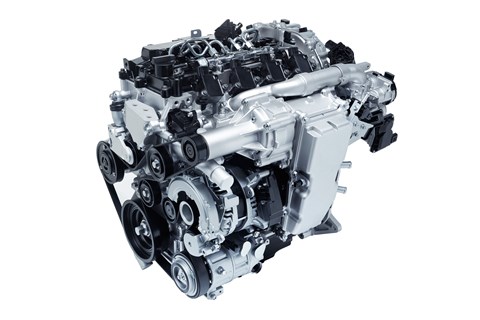► Compression and spark ignition in the same engine
► Mazda claims it’s 20-30% more economical
► A new take on an old idea – this time it has potential
Mazda is claiming the biggest breakthrough in combustion engine technology in decades with its new Spark Controlled Compression Ignition (SpCCI) engine. Why the fuss? Because it combines spark ignition and compression combustion in a petrol engine for the first time. It was first shown in 2018.
CAR magazine was among the first media globally to experience the all-new 2.0-litre engine, which promises the frugality of a diesel with the sporting nature of a petrol engine while delivering a claimed 20-30% improvement in fuel economy.
What exactly is Spark Controlled Compression Ignition?
SpCCI is a natural progression of Mazda’s Skyactiv programme, which it embarked on in 2011 when it launched petrol and diesel engines sharing a common 14:1 compression ratio (CR) – that’s high for petrol and low for diesel. Skyactiv-X operates even higher at 15.0:1.
It’s generally accepted that the higher the CR, the better it is for efficiency and emissions, but there can be issues – with pre-detonation, for instance.
In SpCCI, very high compression rates ignite the air/petrol mix under certain load conditions (like in a diesel engine), with the spark plugs only igniting the fuel from cold start or when under heavy load or acceleration.

Spark ignition (SI) starts the engine with the switch between SI and compression ignition (CI) being seamless, although this does not happen at a set point.
Key to controlling this strategy is a pressure sensor in each cylinder that monitors temperature and pressure to determine if and when compression ignition (CI) should take over from spark ignition (SI).
Both GM and Mercedes-Benz have demonstrated this type of engine technology in the past, but they failed to smooth out the transition between SI and CI – something that Mazda seems to have achieved.
Supercharged, with a sophisticated injection system
As well as running a Roots-type supercharger – Mazda refers to it as an ‘air pump’ – to force extra air into the cylinders, Skyactiv-X has twin variable valve camshafts and a new injection system that delivers fuel at 500bar, compared to 200 for direct injection or 2000 plus for diesel.
The air-fuel mixture for SPCCI is created by splitting injection into two phases for the intake and compression strokes. A strong swirl is created in the combustion chamber to create an intentionally uneven distribution of fuel density with a lean mixture around the periphery for CI and a relatively rich air-fuel mixture around the spark plug in the centre, for creating the fireball.

‘A key breakthrough’
Powertrain executive officer Ichiro Hirose explained that Skyactiv-X is a combination of several breakthroughs:
‘Achieving a super-high compression ratio was a key breakthrough in realising combustion with lean fuel-air mix. Secondly, the leaner you make the air-fuel ratio the more the specific heat ratio increases; to make the big step forward we need to at least double stoichiometric levels from 14.7:1 to 30.0:1.’
But does it work in the real world?
Driving manual and automatic prototype Mazda 3s over a 30-mile test route, including high-speed autobahn as well as urban and country roads, resulted in fuel savings of more than 13% for the manual and upwards of 15% for the auto compared with the equivalent conventionally engine models.
Okay, those figures are nowhere near the claims made by Mazda, but this could be attributed to the atypical driving style used to demonstrate how the engine can pull strongly from as low as 1200rpm in sixth right through to its 6000+rpm red line. Moreover the read-outs revealed that for most of the time the engine ran in SpCCI mode. We’ll be able to test this intriguing new powerplant more thoroughly ahead of its showroom debut in 2018.
Read all of CAR’s Mazda reviews here